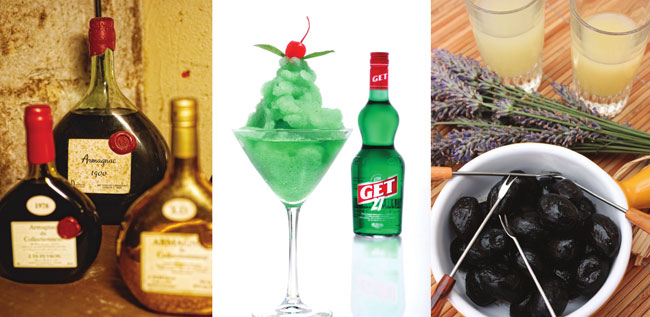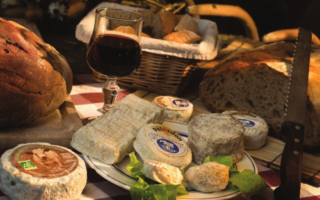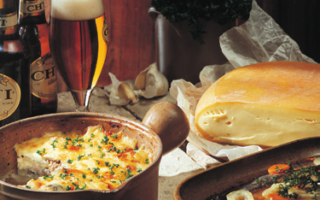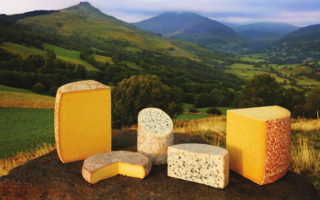Tchin-tchin! A guide to some of the usual and more unusual French spirits

Dominic Bliss looks at the world of French spirits and raises a glass to their place in the country’s social fabric and mealtime traditions
Look at the shelves behind any French bar and the vast array of colourful bottles can be confusing – Suze, Chartreuse, Bénédictine, Get 27, Noilly Prat, Alizé, Genepi, Chambord… what on earth are all these spirits? How are they made and, most importantly, what do they taste like? Understandably, many foreign visitors are baffled by them – only the most adventurous drinkers would dare take a sample.
But that means many of us are missing out. To gain a true understanding of France’s drinking culture, it isn’t enough to be solely an expert in wines and beers, you’ve also got to get to grips with the harder stuff – branch out and brave the distilled spirits…
APÉRITIFS
The obvious place to start is with the apéritif. Derived from the Latin word aperire, meaning to open, they are so-called because they whet, or open up, the appetite. Ludovic Miazga is an international ambassador for Noilly Prat, the brand of vermouth from the south of France. He grew up in Aix-en-Provence – where the mild climate means that drinking apéritifs on sunny terraces is a more of a duty than a custom – and now works in London as a cocktail mixologist.
“The apéritif is more than just a drink,” Miazga explains. “It’s a cultural phenomenon. It’s a very important period of the day, normally between 6pm and 8pm, when the French find themselves at a café or bistro, on a terrace or a balcony. It celebrates the end of the working day when people gather around a drink and exchange ideas. People start to relax, to let go of the tension that they might have built up from working.” The French often invite friends round to their house for an early-evening apéritif. A full dinner invitation would require hours, even days of preparation, and serious financial outlay, whereas an apéritif is quick, cheap and convenient – it’s a sort of ‘dinner party lite’. And if the conversation is flagging somewhat, you know your guests will be out of the door within an hour or so. There’s even something known as the ‘apéritif dinatoire’, which is halfway between an apéritif and a full-on dinner – with drinks and canapés. An apéritif dinatoire might last as long as dinner and you certainly wouldn’t need to eat afterwards.
There’s a physiological as well as a social reason for the apéritif. “It opens up the digestive system,” explains Miazga. “It prepares the senses and the stomach to receive the flavours and tastes of the imminent meal. The apéritif signifies the beginning of the evening meal, so the drink is accompanied with a salty snack, like olives, cheese, nuts or salami.”
Most apéritifs are low in sugar and sometimes low in alcohol so that they don’t overpower the palate before the food arrives. This explains why they’re generally dry rather than sweet: Champagne, vermouth, pastis, gin, whisky, sherry, or even beer at a push. It’ll be interesting to see whether the infamous absinthe, which is hardly low in alcohol and was re-legalised in France during 2011, will establish itself as popular apéritif.
Many French regions have their own version of the apéritif, distilled from local produce. In Provence it’s pastis, the anise-derived drink which is typically mixed with cool water to give it a ‘milky’ effect in the glass. No game of early-evening pétanque is complete without it. In Normandy and Brittany, meanwhile, you might partake of a Pommeau, a mixture of apple juice and calvados. Each corner of France has its favourites: the citizens of the Southwest quaff a ‘floc de Gascogne’, made from grape juice and Armagnac; locals sip on ‘sirop de Picon’, an orange-based bitters, in the Northeast; inhabitants of the Vendée favour troussepinette, made from blackthorn bushes; in the Charentes it’s ‘pineau de Charentes’, made from grape ‘must’ and eau de vie; Burgundians wet their whistles with a kir; while those lucky enough to live in Champagne generally stick to their region’s namesake.
Miazga explains how the desire for local ingredients is just as strong with spirits as it is with food and wine.
“It’s not that people are saying ‘Our apéritif is the best in the world’. They’re just proud of what’s made in their terroir. They’re trying to promote the local savoir faire and local resources.”
In fact, the apéritif is such a cornerstone of French culture that, in 2013, The Institut Français d’Opinion Publique (The IFOP, or The French Institute of Public Opinion) carried out a major poll dealing with the issue. The IFOP discovered that some 47% of French citizens enjoy an apéritif at least once a week, and 4% partake every day. The poll revealed that apéritifs are slightly more popular among French men than women, and the tradition is shared equally across all age groups and socio-economic classes.

DIGESTIFS
Fast forward to the end of the meal and it’s time for the digestif: Cognac, Armagnac, Calvados, eau de vie, and a panoply of fruit and herbal liqueurs. Digestifs can be sweet or dry, and tend to be darker and heavier than apéritifs. They’re so-called because they help you digest your meal and most experts agree that the herb-based varieties are better at this task. Indeed, they were originally distilled by medieval monks, purely for medicinal purposes, as they discovered that herbal and fruity concoctions – however alcoholic – aided digestion.
“I’m not trained in science but it’s to do with stimulating the enzymes in your stomach to help break up the molecules in the meal you’ve just eaten,” says Ludovic Miazga, and advises a certain technique. “Drink digestifs like you eat food. Leave the drink in your mouth, and swirl it around your palate for a few seconds before you swallow. Not only does this allow you to appreciate better the flavour of the drink, but it also creates more saliva in your mouth. This, in turn, triggers the enzymes in your stomach, which will then break up the molecules in the fat and meat you have eaten.
“I’m not saying you have to consume alcohol in order to digest your food,” he adds. “A coffee or a tisane [herbal tea] will also aid digestion, and they don’t contain alcohol at all. Just make sure that you drink responsibly.”
HEAVENLY SPIRITS
Bamboozled by all the booze? Next time you approach a French bar, you’ll be able do it with confidence and savoir faire, thanks to our guide to some of the more unusual French spirits…
SUZE:
Invented in the 1880s by Fernand Moureaux, this brand of bitters flavoured with gentian roots was immortalized in Pablo Picasso’s 1912 painting, Verre et Bouteille de Suze.
GET 27:
Brothers Jean and Pierre Get first devised this mint-based spirit in the late 1700s. The ‘27’ originally referred to the alcohol percentage, which has since been lowered a few notches.

a Noilly Prat advert from a British magazine, circa 1952
NOILLY PRAT:
First developed by herbalist Joseph Noilly in 1813, this vermouth is produced in the Hérault town of Marseillan and includes a secret mix of herbs and spices.
CHARTREUSE:
Legend has it that, in the 1600s, French diplomat Francois Annibal d’Estrées bequeathed an ancient recipe for the elixir of long life to Carthusian monks, which explains the unique mix of herbs, plants and flowers which comprise this liqueur. Modern day Carthusians are still involved in the drink’s distillation process.

BENEDICTINE:
Apparently only three living people at any one time are privy to the precise recipe of this herbal liqueur. So many have attempted to imitate it that, at their Normandy headquarters, the manufacturers maintain a small museum featuring counterfeit versions.
GÉNÉPI:
In the Alps, sooner or later you’ll come across this liqueur made from wormwood. Often used by skiers as a pick-me-up, it has a distillation method known as 40-40-40. That’s 40 twigs of wormwood, 40 grams of sugar and 40 days of steeping in alcohol…
Originally published in FrenchEntrée Magazine
Share to: Facebook Twitter LinkedIn Email
Leave a reply
Your email address will not be published. Required fields are marked *




